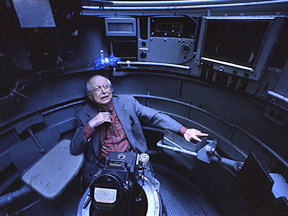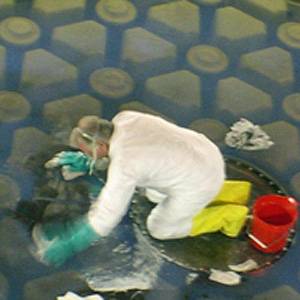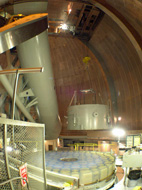In a prior newsletter, I related the
wonderful personal experience Joan and I had spending a night at the
Palomar Observatory. Now, I want to explore the science that astronomers
do there and what it takes to make a giant telescope work.
After giving a presentation to Friends
of Palomar Observatory, we enjoyed a marvelous dinner at the “Monastery”
with astronomer Stan Metchev. Stan graduated from Harvard, got his
Ph.D. from Caltech, and is now an Assistant Professor at SUNY at Stony
Brook.
Stan’s research goal is studying the
atmospheres of exoplanets—planets beyond our Solar System—in pursuit of
one of humanities’ holiest of holy grails: alien life.
As a preparatory step, Stan is refining his technique by studying the
atmospheres of brown dwarfs, watching “storms” move across their face as
they rotate. He invited us to watch him work that night.
Brown dwarfs are “failed stars” that
aren’t massive enough to sustain hydrogen fusion, the power source of
true stars. Brown dwarfs span the gap between the heaviest planets at 1%
of our Sun’s mass and the lightest stars at 8%. Studying brown dwarfs
presents a state-of-the-art challenge, as they can be 10,000 times
dimmer than true stars. The best shot is using infrared light and
Palomar’s “Big Eye.”

We settled in amidst the Ph.D.’s,
astronomy professors, and Jean, the Telescope Operator, who is
ultimately in command. Jean’s primary job is to protect the telescope.
Astronomers tell Jean what they want to do, and Jean decides if and when
to do it. She first evaluates the weather conditions, using an array of
instruments and then by touring the dome’s exterior catwalk and
surveying the sky. Rain, hale, snow, dust, and fire debris are all
hazardous to the telescope’s precision optics. Only if all is clear and
the sun has set, does Jean open the dome. While astronomers control the
imaging systems, Jean controls the telescope, dome, and its shutters.
 While
sitting in a heated control room, in front of a myriad of computer
displays, Stan explained that doing astronomy has become much more
civilized now that imaging is done remotely and electronically. When
imaging required film, astronomers had to spend all night in the “cage”,
where they changed imaging plates at the top of the telescope, 80 feet
above the floor, exposed to the elements. As former Caltech professor
and long-time Palomar astronomer, Jesse Greenstein once said,
astronomers needed a “tough bladder” to stay in the cage for 10 to 15
hours (winters have longer nights). Any motion within the telescope
during an exposure would compromise the image. This picture shows Jesse
at age 85, entering the cage for the last time, sitting in the
astronomer’s chair. While
sitting in a heated control room, in front of a myriad of computer
displays, Stan explained that doing astronomy has become much more
civilized now that imaging is done remotely and electronically. When
imaging required film, astronomers had to spend all night in the “cage”,
where they changed imaging plates at the top of the telescope, 80 feet
above the floor, exposed to the elements. As former Caltech professor
and long-time Palomar astronomer, Jesse Greenstein once said,
astronomers needed a “tough bladder” to stay in the cage for 10 to 15
hours (winters have longer nights). Any motion within the telescope
during an exposure would compromise the image. This picture shows Jesse
at age 85, entering the cage for the last time, sitting in the
astronomer’s chair.
After focusing the telescope, by moving
the cage up and down in steps of 1/10th of an inch, Stan started taking
data. One image showed several brown dwarfs and two fuzzy blobs—“they’re
probably galaxies” he said. Knowing that Palomar has cataloged millions
of galaxies, I naively asked if he could put the cursor on the image
and find out which galaxies these were. Stan replied: “No – because no
one has ever looked at these stars and galaxies before.” I was shocked.
But doing the math confirmed what Stan said. Our universe contains at
least 100 billion galaxies, so we’ve cataloged
less than 1/100th of 1% of what’s out there. Almost everything out
there has never been seen by any human being—there’s virgin sky
everywhere.
For nearly 50 years, Palomar’s Hale
Telescope was the world’s largest—at 5080mm and f/3.3, it’s truly the
“Big Eye.” Astronomers at Palomar have found:
-
29,000 asteroids,
-
200 supernovae,
-
one billion stars,
-
millions of galaxies,
-
20,000 galaxies clusters, and
-
thousands of quasars.
Palomar produced the “Big Picture” now
displayed at Griffith Observatory that is 152 feet long and 20 feet
high. Palomar also discovered many large bodies orbiting our Sun far
beyond Pluto, including Quaoar, Orcus, Sedna, and Eris. As these are
comparable, or even larger than Pluto, their discovery forced
astronomers to formally define what is a “planet”, ultimately leading to
Pluto’s demotion to the status of “dwarf planet.”
 The
Hale telescope was built between 1934 and 1948, funded by a $6 million
gift from the Rockefeller Foundation. The primary mirror is the largest
single-piece mirror in any working telescope and many feel it could
never be replicated. As cast by Corning Glass, the Pyrex honeycomb
mirror weighed 20 tons. Caltech scientists ground the mirror to shape
and polished it to optical smoothness, removing about 10,000 pounds of
glass. The mirror is cleaned weekly, and re-coated with aluminum about
once a year. This image shows the mirror before (top) and after
re-coating. The
Hale telescope was built between 1934 and 1948, funded by a $6 million
gift from the Rockefeller Foundation. The primary mirror is the largest
single-piece mirror in any working telescope and many feel it could
never be replicated. As cast by Corning Glass, the Pyrex honeycomb
mirror weighed 20 tons. Caltech scientists ground the mirror to shape
and polished it to optical smoothness, removing about 10,000 pounds of
glass. The mirror is cleaned weekly, and re-coated with aluminum about
once a year. This image shows the mirror before (top) and after
re-coating.

To coat the mirror, it must first be
unbolted from the telescope and loaded onto a cart. The cart is then
rolled on rails to an open work area. Workers then clean the mirror and
strip away the old aluminum coating with acid, as shown at left, where
the honeycomb support structure is visible. Imagine how careful they
must be not to damage the glass—millionths of an inch really do matter.

Next an 18-ton vacuum chamber cover is
lowered onto the cart, which doubles as the vacuum chamber bottom. The
chamber is sealed far beyond “air-tight”, and slowly evacuated.
Aluminum is then evaporated inside, coating everything inside with an
aluminum film 3-millionth of an inch thick.
It’s all amazing to me.
Best Regards,
Robert
==========================================================================================

You're never too old or too
young to ask "Why?"
Dr. Robert Piccioni
www.guidetothecosmos.com
Author of "Everyone's Guide to Atoms, Einstein, and the Universe"
and "Can Life Be Merely An Accident?"

|